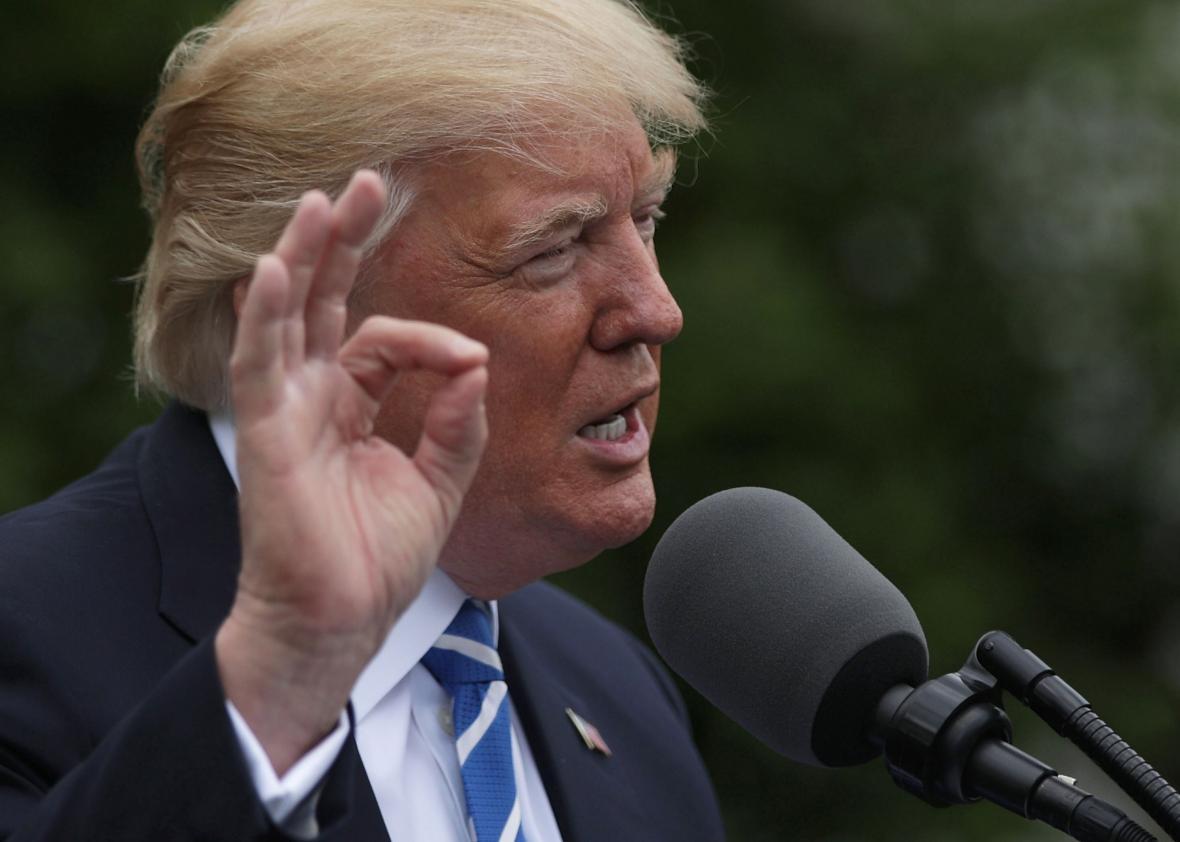Earlier this week, the Wall Street Journal previewed the proposed budget the Trump administration is expected to unveil next week. It would simultaneously cut taxes massively and leave Social Security and Medicare untouched while keeping deficits muted and reducing the ratio of federal debt to GDP. The secret sauce: higher growth, projected endlessly into the future. “The White House projects the nation’s economic growth rate will rise to 3% by 2021, compared with the 1.9% forecast under current policy by the Congressional Budget Office,” the Journal’s Nick Timaroas wrote. He added, dryly: “It’s unusual to see the White House’s growth forecasts differ from the CBO and other blue-chip projections by such a large margin over such a long stretch of the 10-year budget window.” That’s one way to put it!
The focus in the Wall Street Journal article is on the unreasonableness of assuming 3 percent growth endlessly into the future, which would make deficits go away. You can get more output by having more people working and consuming consistently, and you can get more output by having those people work more productively. But our working-age population isn’t growing that much, and productivity has hit something of a plateau. Even with a goose from tax cuts and structural reforms, sustained growth at such a high rate is going to be exceedingly difficult.
It’s even more unrealistic, however, to presume, as the Trump proposal does, that the economy won’t hit a speed bump some time in the next several years.
All presidential budgets are triumphs of hope over experience and reality. And forecasting what will happen in the economy or the world over a 10-year period—and hence how that will affect tax receipts and expenditures on food stamps or defense—is exceedingly difficult. Nobody in 2007 would have—or did—forecast a deep recession that would sap tax rates, require a massive stimulus and bailouts, and lead to several years of trillion-dollar deficits.
There is a natural tendency to forecast by simply extrapolating the recent past endlessly into the future. This works for 10-year plans only if you presume that the business cycle is dead and disruptions don’t happen. In early 2001, after the U.S. had posted very small budget surpluses for the first time in decades, Federal Reserve Chairman Alan Greenspan famously told the Senate that 10-year projections called for an $800 billion surplus in fiscal year 2011. While tentative, these projections “make clear that the highly desirable goal of paying off the federal debt is in reach before the end of the decade,” Greenspan said. He fretted that the government would have no choice but to deploy its vast, recurring surpluses to purchase private assets—socialism realized.
Well. Two months after Greenspan’s testimony, a recession started. Next came 9/11, the Iraq War, the Bush tax cuts, and new spending on education and Medicare prescription drug benefits that put us right back into deficits. In fiscal year 2011, the deficit was $1.3 trillion, meaning Greenspan was off by, oh, $2.1 trillion. And the federal debt, rather than having been paid off, stood at $14.8 trillion in fiscal year 2011. And this was the guy they used to refer to as The Maestro.
Long-term economic and budget forecasts almost never call for a recession. That’s in part because they have become increasingly rare. We live in an age of very long business cycles. The 1980s Reagan-era expansion lasted 92 months, the 1990s expansion went on for 10 full years, the “Bush Boom” of the aughts lasted a little more than six years. The current expansion, which started in July 2009, is approaching its eighth anniversary.
But it’s also because the projection of even the briefest downturn can throw havoc into long-term projections, thus rendering them effectively useless. The budget picture is highly procyclical. When things are going well, you get a double whammy: more tax collections at the same time you’re spending less on unemployment benefits and food stamps. But it works the other way. When growth falters, revenues plummet at the same time spending on social welfare soars and the government is inclined to ramp up stimulus efforts. If you have one year of being down 1 percent instead of being up 2 or 3 percent, you quickly fall behind the curve and you need several years of substantially higher growth to catch up. Between the first quarter of 2008 and the first quarter of 2012, federal revenues didn’t grow at all.
The math behind Trump’s budget proposal only begins to approach the outskirts of plausibility if you believe the economy will experience uninterrupted growth in the coming decade. Now, economic expansions don’t die of old age. And it’s hard to speak with great certainty about the future. It’s better to speak of likelihoods. Is it likely that after eight years of economic growth the economy will suddenly shift permanently into a substantially higher gear and then remain there for years? And that the current expansion will last for at least 18 years—80 percent longer than the longest expansion to date? All at a time when the structure of our workforce and our demonstrated ability to boost productivity seem to argue against higher growth?
If you think the answer to these questions is yes, I have some shares in Trump hotels, casinos, and resorts I’d like to sell you.
